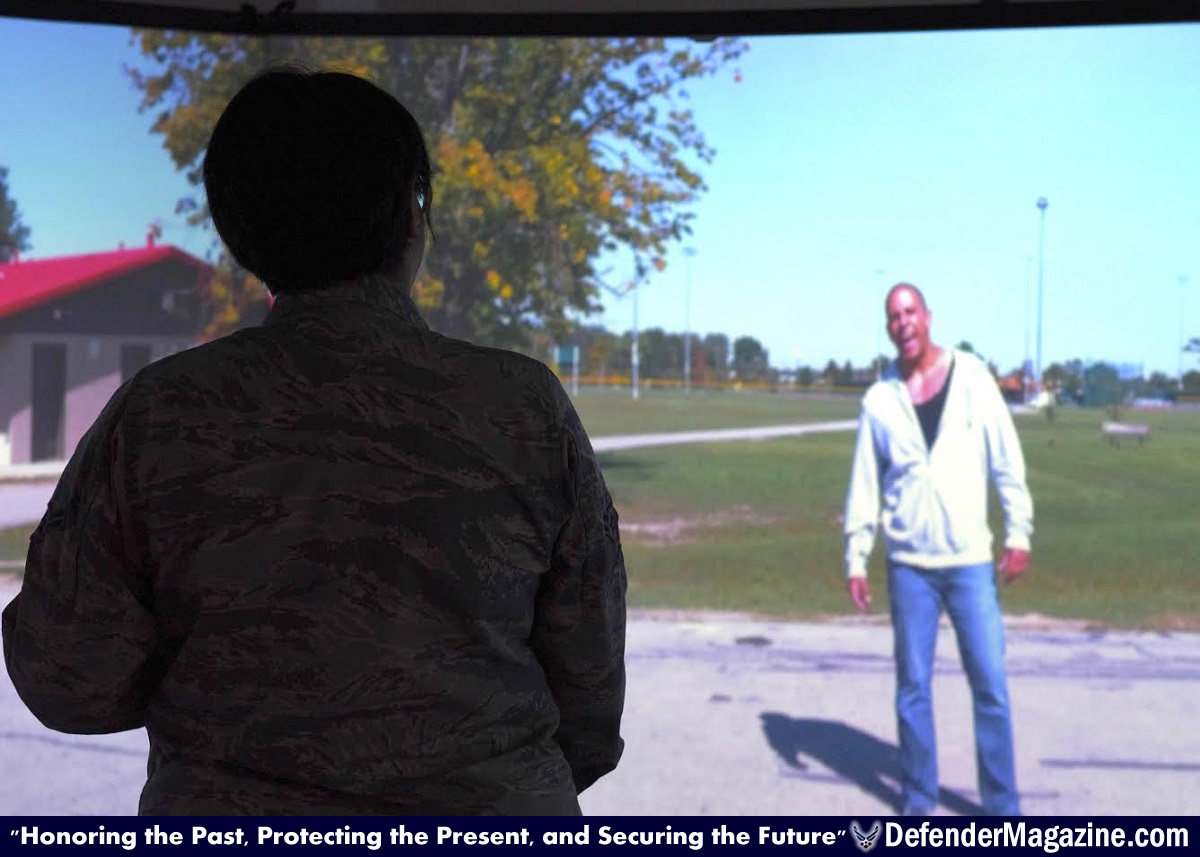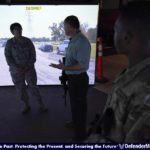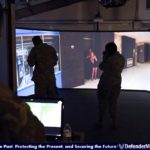Security Forces 300-degree training simulator fully immerses trainees in many different scenarios they may encounter.
Airman 1st Class Lisa Villarreal, 7th Force Support Squadron career development journeyman, left, and Airman 1st Class Jarod Nalls, 7th Equipment Maintenance Squadron aircraft structural maintenance journeyman, right, listens to Richard Cook, 7th Security Forces Squadron instructor, middle, during a debrief after using the Multiple Interactive Learning Objectives training simulator at Dyess Air Force Base, Texas, Sept. 18, 2019. MILO allows trainees to record and then discuss their actions and stances during simulations. (U.S. Air Force photo by Senior Airman Mercedes Porter)
DYESS AIR FORCE BASE, Texas (AFNS) —
Technology around the world is constantly improving, which influences the Air Force to keep up with these new developments by innovating and finding ways to effectively train Airmen.
At Dyess Air Force Base, these updates can be seen in various virtual reality training systems. Now, the 7th Security Forces Squadron is implementing the newly-improved Multiple Interactive Learning Objectives training simulator as part of their regular training curriculum.
“The MILO is a 300-degree training simulator which fully immerses our trainees in many different scenarios they may encounter,” said Staff Sgt. Jordan Valentine, 7th SFS instructor. “This new system forces the Airmen that go through it to really be aware of their surroundings and create muscle memory, unlike our older system which has them stationary in front of one screen.”
The MILO consists of five screens, with trainees placed in the center. During each encounter, Airmen are able to train on the most efficient positions to stand or walk while being recorded from above to review how they handled themselves.
The simulator can create a variety of encounters including active shooters, noise complaints, trespassers and calls regarding individuals who may be in danger.
Each scenario has the ability to be manipulated by an instructor based on the trainee’s responses to conversations or actions. This allows the Airmen to have a more realistic perspective of the different outcomes their actions can cause.
“The Airmen are not only able to train with firearms for the system, but with non-lethal methods like a baton,” said Richard Cook, 7th SFS instructor. “This helps to show them that they are able to use non-lethal ways to stop confrontations in certain situations.”
For both, the instructors and trainees, MILO helps to effectively lower man hours needed for the training. One instructor is able to control the scenes and debrief the Airmen, rather than requiring multiple participants to create a situation for the trainees to react to.
“It was an interesting and new experience when we walked into the new system,” said Airman 1st Class Lisa Villarreal, 7th Force Support Squadron career development journeyman, who was training for her security forces’ augmentee duty. “You become immersed and it made you really think on your surroundings to keep an eye on any potential threats.”
The MILO software also allows security forces members to share scenarios with defenders on other Air Force installations across the U.S.
As the technological world continues to grow, the Air Force will continue to improve Airmen’s training to fly, fight and win.
By Senior Airman Mercedes Porter, 7th Bomb Wing Public Affairs / Published September 24, 2019
Airman 1st Class Lisa Villarreal, 7th Force Support Squadron career development journeyman, speaks to a disgruntled individual during a noise complaint simulation in the Multiple Interactive Learning Objectives training simulator at Dyess Air Force Base, Texas, Sept. 18, 2019. While using the MILO system, trainees are also able to use batons as a non-lethal tactic. (U.S. Air Force photo by Senior Airman Mercedes Porter)
Staff. Sgt. Jordan Valentine, 7th Security Forces Squadron instructor, left, watches Airman 1st Class Jarod Nalls, 7th Equipment Maintenance Squadron aircraft structural maintenance journeyman, middle, and Airman 1st Class Lisa Villarreal, 7th Force Support Squadron career development journeyman, right, as they encounter a simulated active school shooter with the Multiple Interactive Learning Objectives training simulator at Dyess Air Force Base, Texas, Sept. 18, 2019. The MILO system allows trainees to become immersed in a 300-degree view of situations they may find themselves in. (U.S. Air Force photo by Senior Airman Mercedes Porter)


